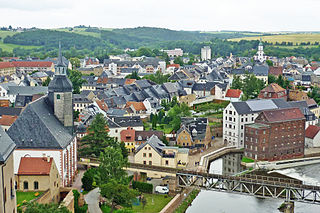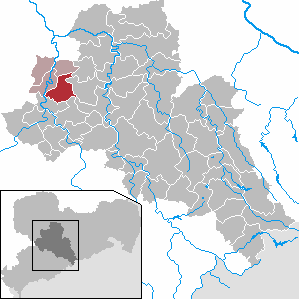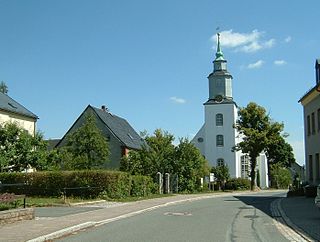
Zwickau is, with around 87,500 inhabitants (2020), the fourth-largest city of Saxony, Germany, after Leipzig, Dresden and Chemnitz and it is the seat of the Zwickau District. The West Saxon city is situated in the valley of the Zwickau Mulde, and lies in a string of cities sitting in the densely populated foreland of the Elster and Ore Mountains stretching from Plauen in the southwest via Zwickau, Chemnitz and Freiberg to Dresden in the northeast. From 1834 until 1952, Zwickau was the seat of the government of the south-western region of Saxony.

Chemnitz is the third-largest city in the German state of Saxony after Leipzig and Dresden. Chemnitz is the third-largest city in the Thuringian-Upper Saxon dialect area after Leipzig and Dresden. It is the fifth largest city in the area of former East Germany after (East) Berlin, Leipzig, Dresden and Halle. The city is part of the Central German Metropolitan Region, and lies in the middle of a string of cities sitting in the densely populated northern foreland of the Elster and Ore Mountains, stretching from Plauen in the southwest via Zwickau, Chemnitz and Freiberg to Dresden in the northeast.

Plauen is, with a population of around 65,000, the fifth-largest city of Saxony, Germany after Leipzig, Dresden, Chemnitz and Zwickau, the second-largest city of the Vogtland after Gera, as well as the largest city in the Saxon Vogtland. The city lies on the river White Elster, in the Central Vogtlandian Hill Country. Plauen is the southwesternmost city of a string of cities sitting in the densely populated foreland of the Elster and Ore Mountains, stretching from Plauen in the southwest via Zwickau, Chemnitz and Freiberg to Dresden in the northeast. It is the capital of the Vogtland District. Plauen borders Thuringia to the north, and it is also situated near the Saxon border with Bavaria (Franconia) and the Czech Republic (Bohemia).

Waldenburg is a town in the district Zwickau in Saxony, Germany. The castle was owned by the House of Schönburg from 1378 until 1945. The pottery town of Waldenburg lies in the valley of the Zwickauer Mulde. The environment is characterized by forest areas, river meadows and the hilly landscape of the Erzgebirge foothills.

Rochlitz is a major district town in the district of Mittelsachsen, in Saxony, Germany. Rochlitz is the head of the "municipal partnership Rochlitz" with its other members being the municipalities of Königsfeld, Seelitz and Zettlitz.

Bergstadt Lößnitz, sometimes also called Muhme (“Aunt”) for its age, is a town in the district of Erzgebirgskreis, Saxony, Germany, and belongs to the Town League of Silberberg. Its name comes from the Slavic lesnice, meaning “forest place”.

Johanngeorgenstadt is a mining town in Saxony’s Ore Mountains, 17 km south of Aue, and 27 km northwest of Karlovy Vary. It lies in the district of Erzgebirgskreis, on the border with the Czech Republic, is a state-recognized health resort (Erholungsort), and calls itself Stadt des Schwibbogens. Its population decline since the 1950s has been extremely severe, falling from 45,000 residents in 1953 to only about one twelfth of that now.

Markneukirchen is a town in the Vogtlandkreis district, in Saxony, Germany, close to the Czech border. It lies in the Elster Mountains, 24 km (14.9 mi) southeast of Plauen, and 14 km (8.7 mi) northeast of Aš.

Mühlau is a municipality in the district of Mittelsachsen, in Saxony, Germany. Mühlau lies in the arch mountain foothills approximately 3 kilometers to the north of Limbach-Oberfrohna, and 15 kilometers northwest of Chemnitz. The settlers of Mühlau originally came from Mehlem on the Rhine. The local name Mühlau is derived from the former home town.

Seelitz is a municipality in the district of Mittelsachsen, in Saxony, Germany. It is part of the administrative partnership Verwaltungsgemeinschaft Rochlitz based in the eponymous town.
The 1963–64 DDR-Oberliga was the 15th season of the DDR-Oberliga, the first tier of league football in East Germany.

Matthias Liebers is a former German professional footballer.
Zwickau is a district (Kreis) in the Free State of Saxony, Germany.
The Dresden–Werdau railway is an electrified, double-track main line in the German state of Saxony. It runs from Dresden via Freiberg, Chemnitz and Zwickau to Werdau wye, where it joins the Leipzig-Hof railway.

The Neukieritzsch–Chemnitz railway is a line in the German state of Saxony. It branches in Neukieritzsch from the Leipzig–Hof railway and runs via Borna and Geithain to Chemnitz Main station. It is part of a long-distance connection between Leipzig and Chemnitz. The route is electrified between Neukieritzsch and Geithain.

Hundshübel is a village in Erzgebirgskreis district of Saxony, forming a subdivision of the municipality of Stützengrün in the Ore Mountains. It is located north of Eibenstock Dam on federal highway B 169.

Martin Böttger was a prominent civil rights activist in East Germany. He was a member of the Landtag of the Free State of Saxony from 1990 to 1994 and led the faction of Alliance '90/The Greens.

The 2018 Chemnitz protests took place in Chemnitz, in the German state of Saxony. In the early morning of 26 August, after a festival celebrating the city's founding, a fight broke out resulting in the death of a German man and serious injuries to two other people. Two Kurdish immigrants, one from Iraq and the other from Syria, were named as suspects. The incident reignited the tensions surrounding immigration to Germany, which had been ongoing since 2015, and the European migrant crisis. In response, mass protests against immigration were ignited by far-right groups. The protests spawned riots and were followed by counter-demonstrations.

Gerd-Helge Vogel is a German art historian.





















